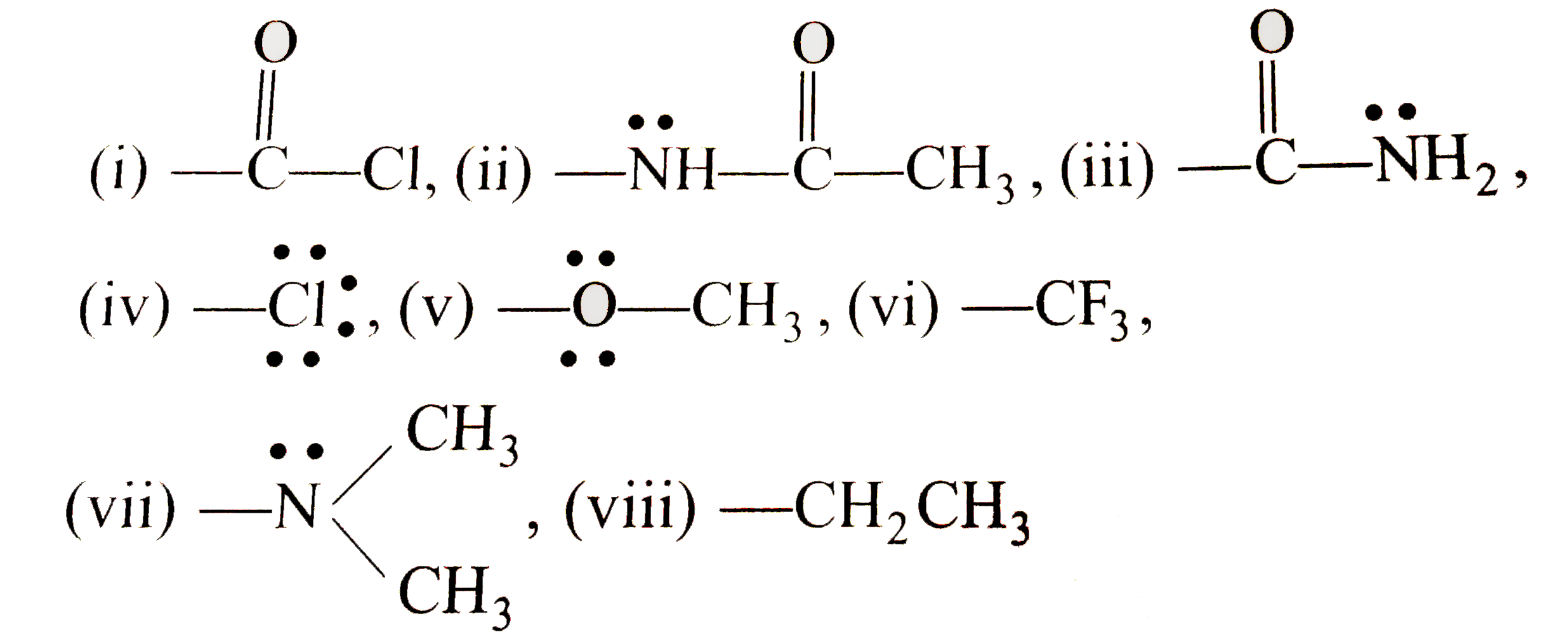Decreasing effect of given is:
(i) , (ii)
(iii) , (iv)
The correct Answer is:D
To determine the decreasing order of the -I (negative inductive) effect of the given groups, we need to analyze the electronegativity and the ability of each group to withdraw electron density from the rest of the molecule. The groups provided are CN (cyano), NO₂ (nitro), NH₂ (amino), and F (fluoro).
1. Identify the Groups and Their Electronegativity:
- CN (cyano): The nitrogen in the cyano group is electronegative and can withdraw electron density.
- NO₂ (nitro): The nitro group has resonance structures where the electronegative oxygen atoms can pull electron density away from the molecule.
- NH₂ (amino): The amino group has nitrogen, which is less electronegative than oxygen and does not have a significant inductive effect.
- F (fluoro): Fluorine is the most electronegative element and has a strong -I effect.
2. Rank the Groups Based on Their -I Effect:
- NO₂: This group has a strong -I effect due to the presence of two electronegative oxygen atoms and resonance structures that stabilize the negative charge.
- CN: The cyano group also has a significant -I effect due to the electronegativity of nitrogen, but it is less than that of NO₂.
- F: Although fluorine is highly electronegative, its -I effect is less pronounced compared to NO₂ and CN because it is a single atom and does not have resonance stabilization.
- NH₂: The amino group has the weakest -I effect among these groups because nitrogen is less electronegative and does not have a charge to withdraw electron density effectively.
3. Final Order:
Based on the analysis, the decreasing order of the -I effect is:
- NO₂ > CN > F > NH₂
- CN (cyano): The nitrogen in the cyano group is electronegative and can withdraw electron density.
- NO₂ (nitro): The nitro group has resonance structures where the electronegative oxygen atoms can pull electron density away from the molecule.
- NH₂ (amino): The amino group has nitrogen, which is less electronegative than oxygen and does not have a significant inductive effect.
- F (fluoro): Fluorine is the most electronegative element and has a strong -I effect.
- NO₂: This group has a strong -I effect due to the presence of two electronegative oxygen atoms and resonance structures that stabilize the negative charge.
- CN: The cyano group also has a significant -I effect due to the electronegativity of nitrogen, but it is less than that of NO₂.
- F: Although fluorine is highly electronegative, its -I effect is less pronounced compared to NO₂ and CN because it is a single atom and does not have resonance stabilization.
- NH₂: The amino group has the weakest -I effect among these groups because nitrogen is less electronegative and does not have a charge to withdraw electron density effectively.
Based on the analysis, the decreasing order of the -I effect is:
- NO₂ > CN > F > NH₂
Topper's Solved these Questions
- SOME BASIC PRINCIPALS OF ORGANIC CHEMISTRYBOOK - A2ZCHAPTER - SOME BASIC PRINCIPALS OF ORGANIC CHEMISTRYEXERCISE - Acid And Basic Strength
29 Videos
- SOME BASIC PRINCIPALS OF ORGANIC CHEMISTRYBOOK - A2ZCHAPTER - SOME BASIC PRINCIPALS OF ORGANIC CHEMISTRYEXERCISE - Bond Fission, Reagents, Reactive Intermediates And Their Stability
31 Videos
- SOME BASIC CONCEPTS OF CHEMISTRYBOOK - A2ZCHAPTER - SOME BASIC CONCEPTS OF CHEMISTRYEXERCISE - Section D - Chapter End Test
30 Videos
- STATES OF MATTERBOOK - A2ZCHAPTER - STATES OF MATTEREXERCISE - Section D - Chapter End Test
30 Videos
Similar Questions
Classify the following groups as ortho, para or meta directing when present on benzene nucleus.
(i) −CH3,(ii)−NH2, (iii) −NO2, (iv)−COOH, (v) −OH, (vi) −SO3H,
(vii) −X(halogen),
(viii) OCH3, (ix) −CHO, (x) −CN
(B) Classify the following goups as activating or deactivating with respect to further electrophilic substitution of the aromatic ring.
(i) −NH2 (ii) −NO2 (iii) −SO3H, (iv) −CH3 (v) −CI, (vi)−CN.
( C) For each of the following substituents indicate whether in donate electron or withdraw electron.

View SolutionThe decreasing order of−I effect of the following is :
(I) COOH
(II) F
(III) OR
(IV) NH2
(V) OH
(IV) Ph−.
View Solution
Knowledge Check
Decreasing −I effect of given groups is :
(i) −CN (ii)−NO2 (iii)−NH2 (iv)−FAiii>ii>i>ivBii>iii>iv>iCiii>ii>iv>iDii>i>iv>iiiDecreasing - I effect of given groups is:
(i) −CN (ii) −NO2
(iii) −NH2 (iv) −ClAiii>ii>i>ivBii>iii>iv>iCiii>ii>iv>iDii>i>iv>iiiWhich of the following is a Bronsted acid ?
(i) HCN , (ii) H2PO−4
(iii) NH+4 , (iv) HCIA(i), (iii)B(i), (ii), (iii), (iv)C(ii), (iii)D(i), (iii), (iv)
The decreasing order of −I effect of the following is :
(I) R⊕4
(II) NO2
(III) CN
(IV) SO3H
(V) COOH.
View SolutionWhich of the following is a Bronsted base ?
(i) NH3 , (ii) CH3NH2
(iii) HCO−3 , (iv) SO2−4
View SolutionArrange the following groups in order of decreasing +M effect
(i) −⊕O (ii) −NH2 (iii) −OH (iv) −NHCOCH3
View SolutionDecreasing order of -I effect of the triad [−NO2,⊕NH3,−CN] is
View SolutionThe decreasing basic order of the following is:
i. Fo−, ii. Clo−, iii. Bro−, Iv. Io−
View Solution
